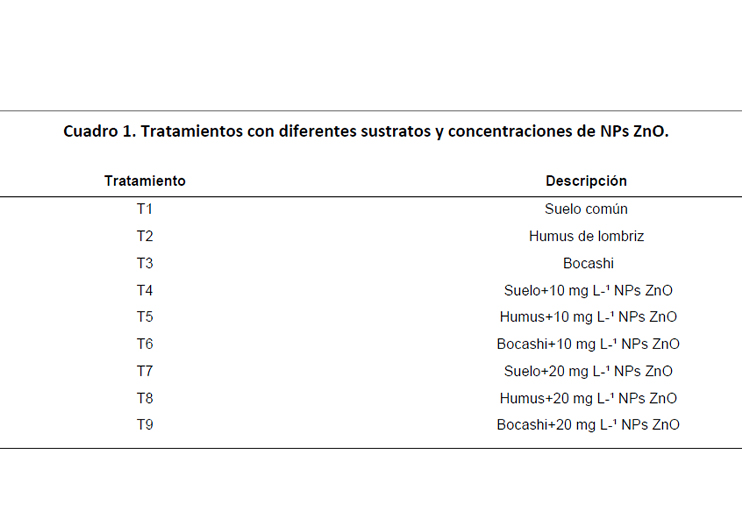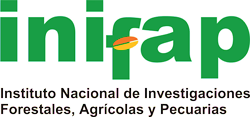Effect of zinc oxide nanoparticles on radish development in organic substrates
DOI:
https://doi.org/10.29312/remexca.v16i30.4038Keywords:
Raphanus sativus L., nanomaterials, organic substrates, zinc oxideAbstract
In recent decades, nanotechnology applied to agriculture has attracted considerable interest due to its potential to boost crop growth and productivity. This research aimed to evaluate the effect of different concentrations of zinc oxide nanoparticles applied to radish plants grown on different organic substrates under low tunnel conditions. The research was conducted at the Chiapas Regional Academic Center of the Antonio Narro Autonomous Agrarian University in 2023. A randomized design with nine treatments and five replications (two plants per replication) was used. The substrates used were common soil, worm humus, and bokashi. During the development of the crop, three applications of zinc oxide nanoparticles of 5 ml per plant were made through the soil at concentrations of 0, 10 and 20 mg L1. Morphological variables of fresh and dry biomass were estimated, which are directly associated with yield. The results showed statistical differences in 10 of the 12 variables evaluated. The best values were obtained in treatments T5 and T8, which represent worm humus in combination with 10 and 20 mg L1 of zinc oxide nanoparticles, respectively. On the contrary, the treatments (T7 and T9) that were grown on the bokashi substrate in combination with zinc oxide nanoparticles had the lowest values, even compared to the control. It is important to explore further the interactions that occur between nanoparticles with different organic substrates and the responses of agricultural crops.
Downloads
References
Ahmed, M.; Marrez, D. A.; Rizk, R.; Zedan, M.; Abdul-Hamid, D.; Decsi, K., Kovács, G. P. and Tóth, Z. 2024. The influence of zinc oxide nanoparticles and salt stress on the morphological and some biochemical characteristics of Solanum lycopersicum L. Plants. 13(10):1418. https://doi.org/10.3390/plants13101418.
CABI. 2019. Raphanus sativus (Radish). CABI digital library. https://www.cabidigitallibrary.org/doi/full/10.1079/cabicompendium.46796#core-ref-5-1.
Diacono, M. y Montemurro, F. 2011. Efectos a largo plazo de las enmiendas orgánicas en la fertilidad del suelo. In: Lichtfouse, E.; Hamelin, M.; Navarrete, M. and Debaeke, P. Ed. Agricultura sostenible, vol. 2. Springer, Dordrecht. 761-786 pp. https://doi.org/10.1007/978-94-007-0394-0-34.
Feng, W.; Sánchez-Rodríguez, A. R.; Bilyera, N.; Wang, J.; Wang, X.; Han, Y.; Ma, B.; Zhang, H; Li, F.Y.; Zhou, J. and Li, Y. 2024. Mechanisms of biochar-based organic fertilizers enhancing maize yield on a chinese chernozem: root traits, soil quality and soil microorganisms. Environmental Technology & Innovation. 36:103756. https://doi.org/10.1016/j.eti.2024.103756.
Fortis-Hernández, M.; García-Delgado, J. D.; Preciado-Rangel, P.; Trejo-Valencia, R.; Sánchez-estrada, A. and Fortiz-Hernández, J. 2022. Commercial and phytochemical quality in biofortified ‘Orejona’ lettuce with zinc oxide nanoparticles. Notulae Botanicae Horti Agrobotanici Cluj-Napoca. 50(4):12969. https://doi.org/10.15835/nbha50312969.
Fleitas-Díaz, M.; Benítez-Pardillo, T. y Castillo, P. R. 2013. Evaluación de humus de lombriz y estiércol bovino en la producción de rábano (Raphanus sativus L.) en condiciones de organopónico. Revista Científica Pakamuros. 1(2):18-22. https://doi.org/10.37787/nvcndj47.
Galindo-Guzmán, A. P.; Fortis-Hernández, M.; Rosa-Reta, C. V.; Zermeño-González, H. y Galindo-Guzmán, M. 2022. Síntesis química de nanopartículas de óxido de zinc y su evaluación en plántulas de Lactuca sativa. Revista Mexicana de Ciencias Agrícolas. 28(esp):299-308.https://doi.org/10.29312/remexca.v13i28.3284.
Giang, D. D. C.; Dung, T. V.; Dong, N. M.; Phuong, N. M. and Long, V. V. 2024. Effects of organic substrate amendments on selected organic fractions and biochemical parameters under different soils. Scientifica. 2024:9997751. https://doi.org/10.1155/2024/9997751.
Garza-Alonso, C. A.; Juárez-Maldonado, A.; González-Morales, S.; Cabrera-Fuente, M.; Cadenas-Pliego, G.; Morales-Díaz, A. B. and Benavides-Mendoza, A. 2023. ZnO nanoparticles as potential fertilizer and biostimulant for lettuce. Heliyon. 9(1):e12787. https://doi.org/10.1016/j.heliyon.2022.e12787.
González-Moscoso, M.; Juárez-Maldonado, A.; Cadenas-Pliego, G.; Meza-Figueroa, D.; SenGupta, B. and Martínez-Villegas, N. 2022. Silicon nanoparticles decrease arsenic translocation and mitigate phytotoxicity in tomato plants. Environmental Science Pollution Research. 29:34147-34163. https://doi.org/10.1007/s11356-021-17665-2.
Gui, X.; Rui, M.; Song, Y.; Ma, Y.; Rui, Y.; Zhang, P.; He, X.; Li, Y.; Zhang, Z. and Liu, L. 2017. Phytotoxicity of CeO2 nanoparticles on radish plant (Raphanus sativus). Environmental Science Pollution Research. 24:13775-13781. https://doi.org/10.1007/s11356-017-8880-1.
Juárez-Maldonado, A.; Ortega-Ortiz, H.; Morales-Díaz, A. B.; González-Morales, S.; Morelos-Moreno, Á.; Cabrera-Fuente, M.; Sandoval-Rangel, A.; Cadenas-Pliego, G. and Benavides-Mendoza, A. 2019. Nanoparticles and Nanomaterials as Plant Biostimulants. International Journal Molecular Science. 20(1):1-19. https://doi.org/10.3390/ijms20010162.
Lata-Álvarez, L. A. y Llerena-Ramos, L. T. 2022. Efecto del humus liquido en variables de crecimiento de plántulas de tomate (Solanum lycopersicum L.). Ciencia Latina. Revista Científica Multidisciplinar. 6(6):769-778.https://doi.org/10.37811/cl-rcm.v6i6.3570.
Lestari, P. G.; Sinaga, A. O. Y.; Marpaung, D. S. S.; Nurhayu, W. and Oktaviani, I. 2024. Application of organic fertilizer for improving soybean production under acidic stress. Oil Crop Science. 9(1):46-52. https://doi.org/10.1016/j.ocsci.2024.02.001.
Liu, L.; Zheng, X.; Wei, X.; Kai, Z. and Xu, Y. 2021. Excessive application of chemical fertilizer and organophosphorus pesticides induced total phosphorus loss from planting causing surface water eutrophication. Scientific Report. 11:23015. https://doi.org/10.1038/s41598-021-02521-.
Magdaleno-García, G.; Juárez-Maldonado, A.; Betancourt-Galindo, R.; González-Morales, S.; Cabrera-Fuente, M.; Sánchez-Vega, M. y Méndez-López, A. 2023. Morfología de nanopartículas de óxido de zinc modifica la germinación y el crecimiento temprano de plántulas de pimiento morrón. Biotecnia. 25(3):5-15. https://doi.org/10.18633/biotecnia.v25i3.1908.
Mahawar, L.; Živčák, M.; Barboricova, M.; Kovár, M.; Filaček, A.; Ferencova, J.; Vysoká, D. and Brestič, M. 2024. Effect of copper oxide and zinc oxide nanoparticles on photosynthesis and physiology of Raphanus sativus L. under salinity stress. Plant Physiology and Biochemistry. 206:108281. https://doi.org/10.1016/j.plaphy.2023.108281.
Mazhar, Z.; Akhtar, J.; Alhodaib, A.; Naz, T.; Zafar, M. I.; Iqbal, M. M.; Fatima, H. and Naz, I. 2023. Efficacy of ZnO nanoparticles in Zn fortification and partitioning of wheat and rice grains under salt stress. Scientific Report. 13:2022. https://doi.org/10.1038/s41598-022-26039-8.
Mendivil-Lugo, C.; Nava-Pérez, E.; Armenta-Bojórquez, A. D.; Ruelas-Ayala, R. D. and Félix-Herrán, J. A. 2019. Elaboración de un abono orgánico tipo bocashi y su evaluación en la germinación y crecimiento del rábano. Biotecnia. 22(1):17-23. https://doi.org/10.18633/biotecnia.v22i1.1120.
Mielcarz-Skalska, L.; Smolińska, B. y Włodarczyk, K. 2021. Nanoparticles as potential improvement for conventional fertilisation in the cultivation of Raphanus sativus var. Sativus. Agriculture. 11(11):1067. https://doi.org/10.3390/agriculture11111067.
Nguyen, N. N.; Nguyen, N. T.; Nguyen, P. T.; Phan, Q. N.; Le, T. L. and Do, H. D. K. 2024. Current and emerging nanotechnology for sustainable development of agriculture: Implementation design strategy and application. Heliyon. 10(10):e31503. https://doi.org/10.1016/j.heliyon.2024.e31503.
Priyanka, N.; Geetha, N.; Ghorbanpour, M. and Venkatachalam, P. 2019. Rol of engineered zinc and copper oxide nanoparticles in promoting plant growth and yield: present status and prospects. Advances in Phytonanotechnology. 183-201 pp. https://doi.org/10.1016/B978-0-12-815322-2.00007-9.
Romero-Figueroa, J. C.; Rodríguez-Mendoza, M. N.; Gutiérrez-Castorena, M. C. y Sánchez-Escudero, J. 2013. Vermicompost como sustrato en la producción de menta (Menta piperita L.). Revista Mexicana de Ciencias Agrícolas. 5(esp):889-899.
Rehman, H. U.; Aziz, T.; Farooq, M.; Wakeel, A. and Rengel, Z. 2012. Nutrición con zinc en sistemas de producción de arroz: una revisión. Plant Soil. 361:203-226. https://doi.org/10.1007/s11104-012-1346-9.
Samuditha, P. S.; Adassooriya, N. M. and Salim, N. 2024. Assessing phytotoxicity and tolerance levels of ZnO nanoparticles on Raphanus sativus: implications for widespread adoptions. Beilstein Journal Nanotechnology. 23(15):115-125. doi:10.3762/bjnano.15.11.
Sarkhosh, S.; Kahrizi, D.; Darvishi, E.; Tourang, M.; Haghighi-Mood, S.; Vahedi, P. and Ercisli, S. 2022. Effect of zinc oxide nanoparticles (ZnO-NPs) on seed germination characteristics in two Brassicaceae family species: Camelina sativa and Brassica napus L. Journal of Nanomaterials. 2022:1892759. https://doi.org/10.1155/2022/1892759.
Saritha, N. G.; Anju, T. and Kumar, A. 2022. Nanotechnology Big impact: how nanotechnology is changing the future of agriculture? Journal of Agriculture and Food Research. 10:100457. https://doi.org/10.1016/j.jafr.2022.100457.
Semenova, N. A.; Burmistrov, D. E.; Shumeyko, S. A. and Gudkov, S. V. 2024. Fertilizers based on nanoparticles as sources of macro and microelements for plant crop growth: a review. Agronomy. 14(8):1646. https://doi.org/10.3390/agronomy14081646.
Singh, A.; Rajput, V. D.; Varshney, A.; Ghazaryan, K. and Minkina, T. 2023. Small Tech, Big Impact: agri-nanotechnology journey to optimize crop protection and production for sustainable agriculture. Plant Stress. 10:100253. https://doi.org/10.1016/j.stress.2023.100253.
Toledo-Manuel, I.; Pérez-Álvarez, M.; Cadenas-Pliego, G.; Cabello-Alvarado, C. J.; Ledezma-Pérez, A. S.; Mata-Padilla, J. M.; Andrade-Guel, M. and Alvarado-Canché, C. N. 2024. Functionalization methods for ZnO nanoparticles with citric acid and their effect on antimicrobial activity. Ceramics International. 50(21):42195-42206. Https://doi.org/10.1016/j.ceramint.2024.08.063.
Yang, S.; Yin, R.; Wang, C.; Yang, Y. and Wang, J. 2023. Phytotoxicity of zinc oxide nanoparticles and multi-walled carbon nanotubes alone or in combination in Arabidopsis thaliana and their mutual effects on oxidative homeostasis. PLoS ONE. 18(2):e0281756. https://doi.org/10.1371/journal.pone.0281756.
Zhang, J.; He, P.; Ding, W.; Xu, X.; Ullah, S.; Abbas, T.; Ai, C.; Li, M.; Cui, R.; Jin, C. and Zhou, W. 2019. Estimating nutrient uptake requirements for radish in China based on QUEFTS model. Scientific Report. 9:11663. https://doi.org/10.1038/s41598-019-48149-6.

Published
How to Cite
Issue
Section
License
Copyright (c) 2025 Revista Mexicana de Ciencias Agrícolas

This work is licensed under a Creative Commons Attribution-NonCommercial 4.0 International License.
The authors who publish in Revista Mexicana de Ciencias Agrícolas accept the following conditions:
In accordance with copyright laws, Revista Mexicana de Ciencias Agrícolas recognizes and respects the authors’ moral right and ownership of property rights which will be transferred to the journal for dissemination in open access. Invariably, all the authors have to sign a letter of transfer of property rights and of originality of the article to Instituto Nacional de Investigaciones Forestales, Agrícolas y Pecuarias (INIFAP) [National Institute of Forestry, Agricultural and Livestock Research]. The author(s) must pay a fee for the reception of articles before proceeding to editorial review.
All the texts published by Revista Mexicana de Ciencias Agrícolas —with no exception— are distributed under a Creative Commons License Attribution-NonCommercial 4.0 International (CC BY-NC 4.0), which allows third parties to use the publication as long as the work’s authorship and its first publication in this journal are mentioned.
The author(s) can enter into independent and additional contractual agreements for the nonexclusive distribution of the version of the article published in Revista Mexicana de Ciencias Agrícolas (for example include it into an institutional repository or publish it in a book) as long as it is clearly and explicitly indicated that the work was published for the first time in Revista Mexicana de Ciencias Agrícolas.
For all the above, the authors shall send the Letter-transfer of Property Rights for the first publication duly filled in and signed by the author(s). This form must be sent as a PDF file to: revista_atm@yahoo.com.mx; cienciasagricola@inifap.gob.mx; remexca2017@gmail.
This work is licensed under a Creative Commons Attribution-Noncommercial 4.0 International license.


